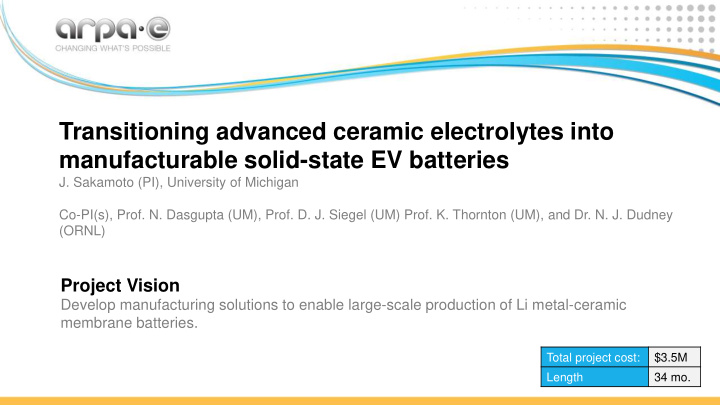



Transitioning advanced ceramic electrolytes into manufacturable solid-state EV batteries J. Sakamoto (PI), University of Michigan Co-PI(s), Prof. N. Dasgupta (UM), Prof. D. J. Siegel (UM) Prof. K. Thornton (UM), and Dr. N. J. Dudney (ORNL) Project Vision Develop manufacturing solutions to enable large-scale production of Li metal-ceramic membrane batteries. Total project cost: $3.5M Length 34 mo.
2X energy density vs Li-ion (1,200 Wh/L) & non-flammable Li-ion Conducting Ceramic 20 µm cycled • Developed ceramic membrane tech to physically stabilize Li metal anodes • Supplanting graphite with Li metal doubles energy density • Replacing combustible liquid with solid electrolyte improves safety • Developed a manufacturing vision that leverages the Li-ion industry • Demonstrated thin Li anode integration
The Team PI: Prof. Jeff Sakamoto: Mechanical Engineering & Materials Science Precision amorphous crystalline ALD Interfaces Co-PI: Prof. Neil Dasgupta: Mechanical Engineering Interface Co-PI: Prof. Don Siegel: Mechanical Engineering Computation Co-PI: Prof. Katsuyo Thornton: Materials Science Interface Mechanics Finite Element Analysis Interface Engineering: Co-PI: Dr. Nancy Dudney: Materials Science & Tech Physical Vapor Deposition 2
Project Objectives: Develop a Scalable Manufacturing Approach Goal Materials Thin film processing Interfaces Cell Architecture 20 Post Plating EIS 18 16 Li-ion Conducting Ceramic 14 -Im(Z) (Ohm*cm2) 12 10 20 µ m cycled 8 R LLZO � R CT � R UC � 6 4 • > 1000 Wh/L Cell 2 • 90 mAh Developed ceramic Cathode� 0 architecture • 0 5 10 15 20 5 cm bend formulations that Re(Z)*Area (Ohm*cm2) LLZO� addresses M� • 400 cycles are stable against Engineered surfaces brittle nature • > 3mAh/cm 2 Li. 1-7 enable < 15 W .cm 2 ASR of ceramic • 1 C rate 50� µ m� produced with a scale- membranes. 8 Processing of high able process. 6 density ceramic battery components. Engineer to minimize peripheral mass/volume. 1,3,4 July 26, 2019 3
Maintaining Mechanical Integrity Challenging When Li & Ceramic ≈ 10 – 20 µm Reinforce Ceramic with Li Distortion Fracture Load Bearing Cathode Robust Cathode Rigid Assembly Cathode Cathode ~1mm Electrolyte Pellet Li-ion Conducting Ceramic Li 10 µm 10 µm • Strong & stiff as Al alloy • E-chem performance Li metal 9 maintained. 10 July 26, 2019 4
Thin Film Ceramic Tile Array & Li Anode Integration Cerami Li c 50 µm Maintain < 15 W .cm 2 ASR after rolling. 5 cm bend radius. 8 July 26, 2019 5
Challenges and Potential Technical Partnerships ‣ Relevant Ceramic Processing Expertise in US is not Common – Fortunate to have Identified A Potential Ceramic Partner ‣ Currently Pursuing Li-ion Battery Manufacturers Interested in SSB Pilot- Line Manufacturing ‣ Interest in Engaging End Users Requiring High Energy Density & High Stability Batteries
T2M Integrate new Ceramic membrane & processes into pilot line composite cathode Micro • Material suppliers electronics Li-ion manufacturer • Ceramic processing Mobility Start-up option to Next steps : license in place • Launch UM spin-off ( Zakuro LLC) with Arpa-E Plus-Up 18 Patents • Translate to full-scale manufacturing with partner 2 issued Exit Strategy • Acquisition by partner • Maintain research arm to advance SSB technology July 26, 2019 7
Referenced Patents (of 18) and *Peer-Reviewed Manuscripts (of 44) 1. US 9093717 B2 (Issued): Methods of making and using oxide ceramic solids and products and devices related thereto. 2. US 20160293988 A1 (Issued) : Template-based methods of making and using ceramic solids and products and devices related thereto. 3. US Application: 62/268,545, filed 12/17/2015 OTT 6746, Slurry Formulation for the Formation of Layers for Solid State Batteries. 4. US Application: 62/360,770, filed 7/11/2016 OTT 7102: Ceramic Based Ionically Conducting Material. 5. *Thompson, T., Yu, S., Williams, L., Schmidt, R.D., Garcia-Mendez, R., Wolfenstine, J., Allen, J.L., Kioupakis, E., Siegel, D.J. and Sakamoto, J., 2017. Electrochemical window of the Li-ion solid electrolyte Li7La3Zr2O12. ACS Energy Letters, 2(2), pp.462-468. 6. *Sharafi, A., Kazyak, E., Davis, A.L., Yu, S., Thompson, T., Siegel, D.J., Dasgupta, N.P. and Sakamoto, J., 2017. Surface chemistry mechanism of ultra- low interfacial resistance in the solid-state electrolyte Li7La3Zr2O12. Chemistry of Materials, 29(18), pp.7961-7968. *Ma, C., Cheng, Y., Yin, K., Luo, J., Sharafi, A., Sakamoto, J., Li, J., More, K.L., Dudney, N.J. and Chi, M., 2016. Interfacial stability of Li metal – solid 7. electrolyte elucidated via in situ electron microscopy. Nano letters, 16(11), pp.7030-7036. 8. US Application: 62/289,559, filed 2/1/2017 OTT 6744, Segmented Cell Architecture for Solid State Batteries. 9. *Masias, A., Felten, N., Garcia-Mendez, R., Wolfenstine, J. and Sakamoto, J., 2019. Elastic, plastic, and creep mechanical properties of lithium metal. Journal of Materials Science, 54(3), pp.2585-2600. 10. US Provisional Patent Application filed May 24, 2019. July 26, 2019 8
Recommend
More recommend